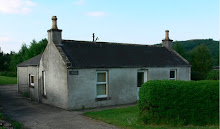
I've always liked how the tree trunk's storage of data was similar to that of vinyl records (a comparison made many times, see below) and how they serve as the perfect way to illustrate timelines. The scene in Hitchcock's Vertigo (and explicitly referenced in Chris Marker's La Jetee and Terry Gilliam's remake of it, 12 Monkeys) perhaps best conveys the wonder of contemplating inter-generational time thru a single object:
MADELEINE: How old?
SCOTTIE: Oh... some, two thousand years, or more.
MADELEINE: The oldest living things?
SCOTTIE: (Nodding, as he watches her, wondering, as she looks about thoughtfully) You've never been here before?
MADELEINE: (Shakes her head, lost in thought as she lets her gaze wander among the trees)
SCOTTIE: What are you thinking?
MADELEINE: (Searching) Of all the people who have been born... and have died... while the trees went on living.
SCOTTIE: (Agreeing) Their true name is Sequoia Sempervirens: always green, ever- living.
MADELEINE: (Flatly) I don't like them.
SCOTTIE: Why?
MADELEINE: (Simply) Knowing I have to die...
..............
EXT. RED WOODS - (DAY) - CLOSE SHOT We see the two profiles: Madeleine staring at the tree, Scottie staring at Madeleine. She raises one gloved hand and almost idly begins to trace a finger up along the white line that is marked: 1776 DECLARATION OF INDEPENDENCE. And as the hand moves a little to the left, Madeleine begins to speak, almost vacantly, oblivious of all but this piece of tree, and herself.
MADELEINE: Somewhere in here I was born... and here I died and it was only a moment for you... you took no notice...
Tree-rings (or 'annual rings') are also now helping to rewrite history, chart weather patterns, determine what year ancient volcanoes erupted, forecast fire systems, etc. etc.
Earlier this summer tree-rings solved a mystery that was two-and-a-quarter centuries old. In New England, on May 19, 1780, in the middle of the day, it was dark as night. Many thought judgment day had arrived. Abraham Davenport, a member of the legislature of Connecticut, famously announced "I choose, for one, to meet Him face to face, No faithless servant frightened from my task, But ready when the Lord of the harvest calls; And therefore, with all reverence, I would say, Let God do His work, we will see to ours. Bring in the candles."
Known as New England's Dark Day, or Black Friday, the event has long been the subject of speculation, but with little scientific consensus. Some suspect it might have just been a particularly bad overcast day, but records indicate that there was less than one-tenth the sunlight one would expect on a cloudy day. People reportedly ate by candlelight, animals behaved strangely, and night birds came out to sing. Another suggestion was that massive wildfires were the cause, though this was quickly dismissed as 'simple and absurd.' Limited long-distance communication at the time prevented colonists from verifying their hypotheses.
But in June of this year researchers at the University of Missouri used tree rings as "ecological artifacts" to determine that fires in Canada were likely the cause. Large numbers of trees in the Algonquin Park in Ontario were found to have scars indicating a massive wildfire occurred in 1780, strong enough to have caused atmospheric conditions hundreds of miles away.





No comments:
Post a Comment